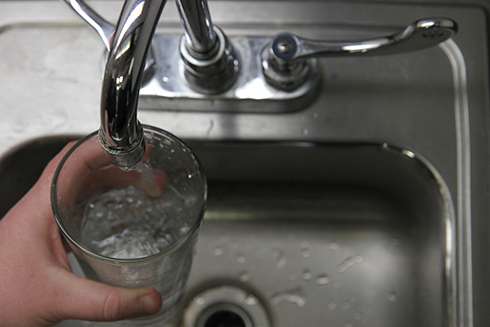Don't let complex language keep you from drinking tap water, researchers say

With the rise in bottled water and sugary beverage alternatives, regular tap water is struggling to make its way into the daily U.S. diet.
Part of the problem may be the technical language used to communicate important water quality information to the public, according to an interdisciplinary team of Virginia Tech researchers recently writing in the Journal of Water and Health.
The language in reports issued by drinking water utilities and service providers reads like scientific or academic writing, explained Siddhartha Roy of Palanpur, India, a doctoral student in civil and environmental engineering in the College of Engineering and a member of the Virginia Tech Water INTERface Interdisciplinary Graduate Education Program.
"The concern is that many people may not be able to comprehend what these reports really show, and therefore may avoid drinking tap water as a result," Roy said.
The U.S. Environmental Protection Agency annually requires water systems that supply at least 15 service connections, or 25 people year-round, to disclose where the water comes from and what's in it through Consumer Confidence Reports.
The reports supply details about detected contaminants and compliance to drinking water regulations so that consumers can make informed decisions about the quality, treatment, and management of their tap water.
But when the writing in the reports is hard to understand, people may lose trust in water and water suppliers, the researchers said.
"Measuring readability is an important parameter for gauging a public health messaging medium for drinking water that has been in place for over 15 years," Roy said. "One way our analyses can help is to encourage reevaluation and modification of the reports to better target the American population, which may lead to increased trustworthiness of drinking water and the water utilities that work hard to meet current regulations."
Roy worked with Brenda Davy, an associate professor of human nutrition, foods, and exercise in the College of Agriculture and Life Sciences, a core faculty member in the Virginia Tech Water INTERface Interdisciplinary Graduate Education Program, and a Fralin Life Science Institute affiliated researcher in the Fralin Translational Obesity Research Center.
According to Davy, possible public misperception of water safety may affect alternative beverage choices and, ultimately, public nutrition and health.
"One concern is that people might perceive soft drinks or other sugar-sweetened beverages as a better, safer choice than tap water," Davy said. "In addition, the comprehensibility of the reports could be a particular problem for individuals with lower incomes and lower educational levels who are at increased risk for obesity and many other health conditions."
Davy's concern began when she received a report in the mail. After reading it, she became unsure about her tap water's safety and about the effects the reports might have on consumers.
Davy gathered colleagues well versed in all things water, including civil and environmental engineers, a health and nutrition scientist, and an agricultural and applied economics specialist.
The team evaluated a nationally representative sample of reports using Flesch-Kincaid readability tests, which use sentence length and the amount of words and syllables to measure English reading ease and the U.S. grade-level equivalent.
On average, the difficult-to-read reports were written at 11th-grade to college undergraduate levels, similar to the Harvard Law Review.
The National Institutes of Health recommends health communication materials be written at sixth- to seventh-grade levels.
"Better communication will hopefully increase the public's reliance on tap water for their needs and steer people away from sugar-sweetened beverages as well as bottled water—the former, which affects health, and the latter, your pocket," Roy said.
Writers should use shorter sentences and words, and break long sentences into bullet points. Charts, graphs, and visual representations of content are also helpful, the researchers said.
"For water quality report writers, finding ways to simplify complexity without compromising the science is a formidable challenge," Roy said. "If a national effort is led in conjunction with public health and communication experts to better word and illustrate these reports, we could really make a difference in consumer perceptions and actions—even if it is a small percentage."
More information: "An evaluation of the readability of drinking water quality reports: a national assessment." Journal of Water and Health In Press, Uncorrected Proof © IWA Publishing 2015, DOI: 10.2166/wh.2015.194


















